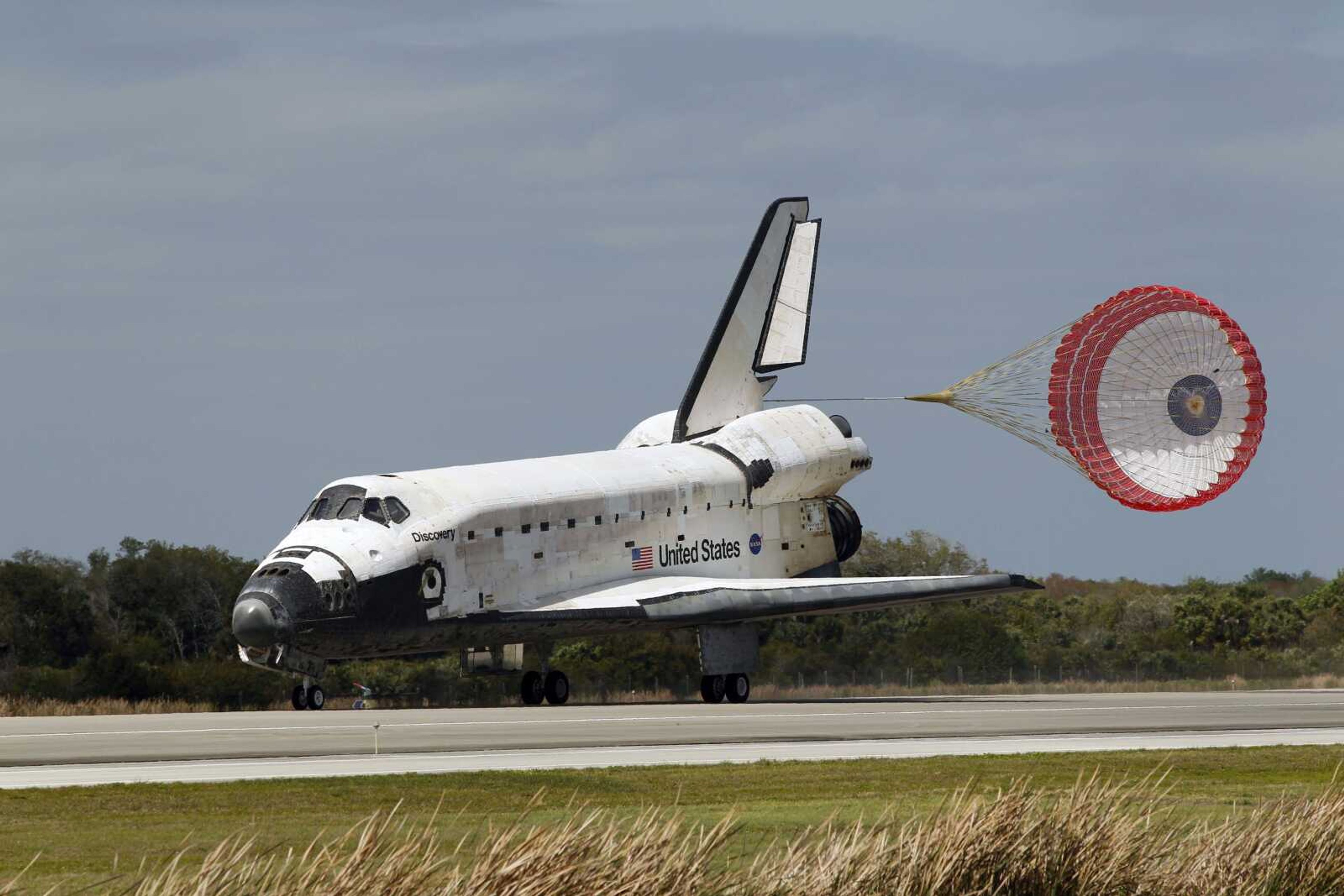Shuttle Discovery ends flying career; museum next
CAPE CANAVERAL, Fla. -- Discovery ended its career as the world's most flown spaceship Wednesday, returning from orbit for the last time and taking off in a new direction as a museum piece. After a flawless trip to the International Space Station, NASA's oldest shuttle swooped through a few wispy clouds on its way to its final touchdown...
CAPE CANAVERAL, Fla. -- Discovery ended its career as the world's most flown spaceship Wednesday, returning from orbit for the last time and taking off in a new direction as a museum piece.
After a flawless trip to the International Space Station, NASA's oldest shuttle swooped through a few wispy clouds on its way to its final touchdown.
"To the ship that has led the way time and time again, we say, 'Farewell Discovery,"' declared Mission Control commentator Josh Byerly.
When it landed three minutes before 11 o'clock CST, Discovery ceased being a reusable rocket ship.
"For the final time: wheels stop," commander Steven Lindsey called out when the shuttle rolled to a stop. He was the last of the six crew members to climb out of the shuttle.
"It came back as perfect on its final flight as it did on its first flight," said Lindsey,.
Even after shuttles Endeavour and Atlantis make their final voyages in the coming months, Discovery will still hold the all-time record with 39 missions, 148 million miles, 5,830 orbits of Earth, and 365 days spent in space. All that was achieved in under 27 years.
Discovery now leads the way to retirement as NASA winds down the 30-year shuttle program in favor of interplanetary travel.
NASA estimates it will take several months of work -- removing the three main engines and plumbing with hazardous fuels -- before Discovery is ready for the Smithsonian Institution. Engineers also will remove some parts to study them for future spacecraft.
Officials expect to hand Discovery over sometime this fall. It will make the 750-mile journey strapped to the top of a jumbo jet.
Throughout the flight, Lindsey and his crew marveled at how well Discovery was performing. They noted that the spacecraft was going into retirement still "at the top of her game."
Discovery's last mission unfolded smoothly despite a four-month grounding for fuel tank repairs and a liftoff Feb. 24 in the last two seconds of the countdown.
Perhaps more than any other shuttle, Discovery consistently delivered.
It made its debut in 1984 following shuttles Columbia and Challenger, dispatched the Hubble Space Telescope in 1990, flew the first shuttle rendezvous to Russia's Mir space station and carried the first female shuttle pilot in 1995, and gave another ride into space to John Glenn, the first American to orbit the Earth, in 1998.
It got NASA flying again, in 1988 and 2005, following the Challenger and Columbia disasters. And it flew 13 times to the space station, more than any other craft. On its last trip, it delivered a new storage compartment packed with supplies and a humanoid robot.
"You're sad to see her be retired, but at the same time, it's really a pride thing. We got her back OK. It was a beautiful mission," said Ken Smith, a Boeing propulsion manager who monitored the shuttle's systems from the landing strip.
But he added: "We've got two more to fly."
Launch director Mike Leinbach acknowledged "there were no big emotional outbursts and tears" on the runway. While there was a mood of "can't believe the program is coming to an end," the team carried out its job as usual, he noted.
"The time for reflection, I think, comes later," Leinbach told reporters.
NASA is ending the shuttle program because it's under presidential direction to spread its wings beyond low-Earth orbit. The goal is to send astronauts to an asteroid and then Mars in the decades ahead. There is not enough money for NASA to achieve that and maintain the shuttle program at the same time. As a result, the shuttles will stop flying this summer after 30 years.
Endeavour is due to blast off April 19, Atlantis on June 28.
American astronauts will keep hitching rides to the space station on Russian capsules, until private companies are able to provide taxi service to and from orbit. NASA expects to get another nine years out of the space station.
The Discovery astronauts took several minutes to go through the long receiving line on the runway. NASA's boss, Charles Bolden, a former shuttle commander who twice flew Discovery, led the welcoming party and called it "an absolutely incredible flight." Earlier in the morning, he joined about 50 local eighth-graders eager to see history in the making.
Bolden will announce the final homes for Endeavour and Atlantis on April 12 -- 30 years to the day that Columbia soared on the first shuttle flight.
NASA wanted to move Endeavour out to the launch pad Wednesday night. But that trip was delayed until at least Thursday because bad weather was expected. The mission will be commanded by the husband of wounded Rep. Gabrielle Giffords, Mark Kelly. His identical twin brother Scott is currently the skipper of the space station; he returns to Earth next week on a Russian Soyuz spacecraft.
Scott Kelly and his station crewmates watched Discovery's landing via a laptop computer.
"Nice to have our friends home safe!" astronaut Catherine Coleman wrote in a Twitter update.
Connect with the Southeast Missourian Newsroom:
For corrections to this story or other insights for the editor, click here. To submit a letter to the editor, click here. To learn about the Southeast Missourian’s AI Policy, click here.









